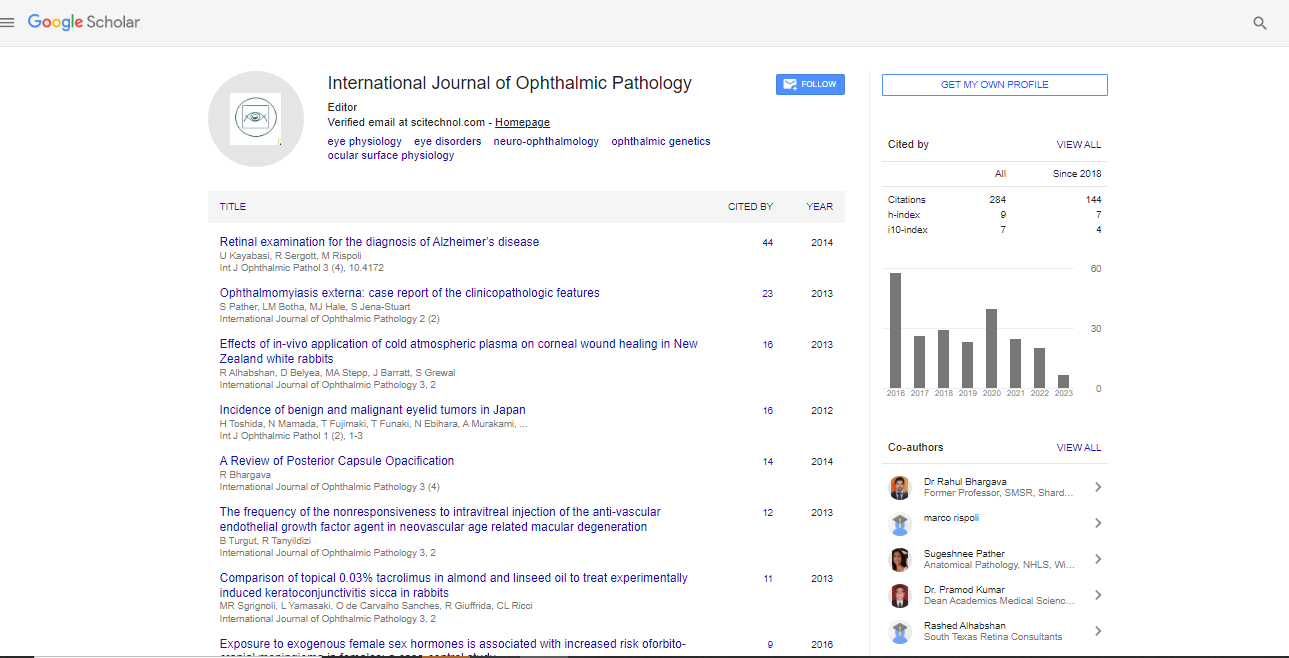Review Article, Int J Ophthalmic Pathol Vol: 0 Issue: 0
Blindness in Children: Worldwide Frame of Mind
Maryann J Gray*
Department of Ophthalmology, UCLA University of California, Los Angels, USA.
*Corresponding Author:
Maryann J Gray
Department of Ophthalmology, UCLA University of California, Los Angels, USA.
E-mail: mgray@conet.ucla.edu
Received: June 30, 2021 Accepted: July 14, 2021 Published: July 21, 2021
Citation: Gray MJ (2021) Blindness in Children: Worldwide Frame of Mind. Int J Ophthalmic Pathol 10:7. (288)
Abstract
Many of the causes of childhood blindness are avoidable, being either preventable or treatable. Only three per cent of the world's blind populations are children. However, since kids have a long period of visual deficiency in front of them, the quantity of 'dazzle individual years' coming about because of visual deficiency beginning in youth is second just to cataract.
Keywords: Blindness, cataract
Introduction
Many of the causes of childhood blindness are avoidable, being either preventable or treatable. Only three per cent of the world's blind populations are children. However, since kids have a long period of visual deficiency in front of them, the quantity of 'dazzle individual years' coming about because of visual deficiency beginning in youth is second just to cataract. Controlling visual impairment in youngsters is a need of vision in any case, as its causes contrast from that of visual deficiency in grown-ups, various systems, work force, framework, and gear are needed to battle it. There is additionally a more prominent earnestness while overseeing youngsters, as deferrals in treatment can prompt amblyopia (lazy eye).
Discussion
The World Health Organization's (WHO) system for classifying visual deficiency and low vision in kids utilizes two methods. The main strategy, an enlightening order, alludes to the anatomical site generally influenced. The accompanying categories are used:
- whole globe (e.g. anophthalmos, microphthalmos)
- cornea (e.g. corneal scarring, keratoconus)
- lens (e.g. cataract, aphakia)
- uvea (e.g. aniridia)
- retina (e.g. retinal dystrophies)
- optic nerve (e.g. atrophy)
- glaucoma
- conditions where the eye appears normal (e.g. refractive errors, cortical blindness, amblyopia).
The data important for this clear grouping can be gathered on each kid following assessment and clinical appraisal.
The subsequent technique, an aetiological arrangement, groups visual impairment as per fundamental reason. This technique utilizes classifications dependent on the hour of beginning of the condition:
- Hereditary (genetic diseases, chromosomal abnormalities)
- Intrauterine (during pregnancy, due to rubella or thalidomide)
- Perinatal (e.g. retinopathy of prematurity, birth injury)
- Childhood (e.g. vitamin A deficiency disorders, trauma)
- Unknown/cannot be determined
Information about underlying causes of blindness, although often more difficult to collect, is more useful for planning.
Changes in the Causes of Blindness over Time
Economic development and explicit intercessions are changing the example of visual impairment in youngsters everywhere, including India. For instance, more broad projects of measles inoculation and better control of nutrient An insufficiency problems are lessening corneal visual impairment in some low-pay nations; waterfall is turning out to be more significant. In center pay nations, neonatal escalated care administrations are growing; retinopathy of rashness is currently a significant conceivably avoidable reason for youth visual deficiency in numerous nations in Latin America, Eastern Europe, and urban areas in Asia.
Planning for the Control of Blindness in Children
Vision backers getting ready for the control of visual impairment in youngsters for a complete populace of 10 million. how the extent and reasons for visual deficiency change by level of financial turn of events; various locales will, hence, have various needs for control. Preventable causes can be decreased at the essential degree of administration conveyance, though treatable causes require particular pediatric ophthalmology units, frameworks for early ID, reference and follow-up, and expanded public mindfulness. All encompassing, complete, multi-sectoral approaches are required, incorporating arrangement for youngsters with low vision.
References
- Gilbert CE, Foster A, Negrel AD (1993) Childhood blindness: a new form of recording causes of vision loss in children. Bull World Health Org 71:485–489.
- Rahi JS, Gilbert CE, Foster A (1999) Measuring the burden of childhood blindness. Br J Ophthalmol. 83:387–388.
- Gilbert C, Rahi J, Quinn G (2003) Visual impairment and blindness in children. In: Johnson, Minassian, Weale, West, eds. Epidemiology of Eye Disease. 2nd edition. London: Arnold Publishers.
 Spanish
Spanish  Chinese
Chinese  Russian
Russian  German
German  French
French  Japanese
Japanese  Portuguese
Portuguese  Hindi
Hindi 